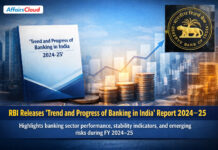 On June 24, 2021, the Reserve Bank of India (RBI) linked the declaration of dividend by non-banking finance companies (NBFCs) to their minimum prudential norms on Capital to Risk-Weighted Assets Ratio (CRAR) and Non-Performing Assets (NPAs).
On June 24, 2021, the Reserve Bank of India (RBI) linked the declaration of dividend by non-banking finance companies (NBFCs) to their minimum prudential norms on Capital to Risk-Weighted Assets Ratio (CRAR) and Non-Performing Assets (NPAs).
- In order to infuse greater transparency and uniformity in the payout practice, RBI has issued guidelines on the distribution of dividend by NBFCs to be effective from the profits of Financial Year 2022 (FY22) and onwards.
What is Dividend?
It is the sum of money distributed by a company, to its shareholders, out of the profits made by it, in proportion to the amount paid upon each share held by them. It will be declared by the Board of Directors(BoD) of the company.
RBI’s Guidelines for NBFCs’ Declaration of Dividend:
a.Eligibility criteria:
RBI has stated the minimum prudential requirements to be eligible to declare dividend as follows.
| Parameter | Requirements |
|---|---|
| CRAR | Deposit-taking NBFCs (other than standalone primary dealers(SPDs)) should have a CRAR (consisting of Tier-I and Tier-II capital) of at least 15 percent for the last 3 years, including the accounting year for which it proposes to declare a dividend. |
| Housing Finance Companies(HFCs) should maintain CRAR consisting of Tier-I and Tier-II capital which shall not be less than 13 percent (as of March 31, 2020), 14 percent (on or before March 31, 2021), and 15 percent (on or before March 31, 2022, and thereafter). | |
| SPDs should have maintained a minimum CRAR of 20 percent for the FY for which a dividend is proposed. | |
| Net NPAs Ratio | It should be less than 6 percent in each of the last 3 years, including the accounting year for which it proposes to declare a dividend. |
| Other Criteria | NBFCs should comply with the provisions of Section 45 IC of the RBI Act, 1934 and the HFCs need to comply with the provisions of Section 29 C of the National Housing Bank (NHB) Act, 1987. Note – RBI/ NHB has not placed any explicit restrictions on the declaration of dividend. |
b.Dividend Payout Ratios (DPR)Ceilings:
i.DPR: It is the ratio between the amount of the dividend payable in a year and the net profit as per the audited financial statements for the FY for which the dividend is proposed.
ii.RBI has issued guidelines on DPR for NBFCs that are eligible to declare dividend as follows.
| Type of NBFC | Maximum DPR (percentage) |
|---|---|
| NBFCs that do not accept public funds and do not have any customer interface | No ceiling |
| Core Investment Company | 60 |
| Standalone Primary Dealers | 60 |
| Other NBFCs | 50 |
iii.A NBFC (other than SPD) which does not meet the eligible criteria, may be eligible to declare a dividend, subject to a cap of 10 percent on the dividend payout ratio, only if it has a net NPA of less than 4 percent as at the close of the FY.
iv.The proposed dividend should include both dividend on equity shares and compulsorily convertible preference shares eligible for inclusion in Tier 1 capital.
v.In case of SPDs which have a CRAR at or above the regulatory minimum of 15 per cent during each of the quarters of the previous year, but lower than 20 per cent in any of those quarters, the dividend payout ratio shall not exceed 33.3 per cent.
c.Board Oversight:
i.As per the RBI guidelines for the BoD of the NBFC, they should take into account the supervisory findings of the RBI with regard to divergence in the identification of NPAs and shortfall in provisioning while considering the proposals for the dividend.
ii.The BoD also has to report the details of, the dividend declared by the NBFC during the FY, long term growth plans of the NBFC, and the auditors’ qualifications pertaining to the statement of accounts.
Note – In December 2020, the RBI issued the draft guidelines on dividend payout by NBFCs. Click here to know more
Recent Related News:
On May 24, 2021, the RBI notified the guidelines for the Amalgamation of one or more District Central Co-operative Banks (DCCBs) in a State with State Co-operative Bank (StCB) or amalgamation of one DCCB with another.
On May 19, 2021, Under Section 18 read with Section 10(2) of the Payment and Settlement Systems Act, 2007, RBI has mandated that all prepaid payment instruments (PPIs) or mobile wallets such as Paytm, PhonePe and Mobikwik that are fully KYC-compliant be made interoperable by March 31, 2022.
About Reserve Bank of India(RBI):
Establishment – 1st April 1935
Headquarters – Mumbai, Maharashtra
Governor – Shaktikanta Das
Deputy Governors – Mahesh Kumar Jain, Michael Debabrata Patra, and M Rajeshwar Rao, T. Rabi Sankar




